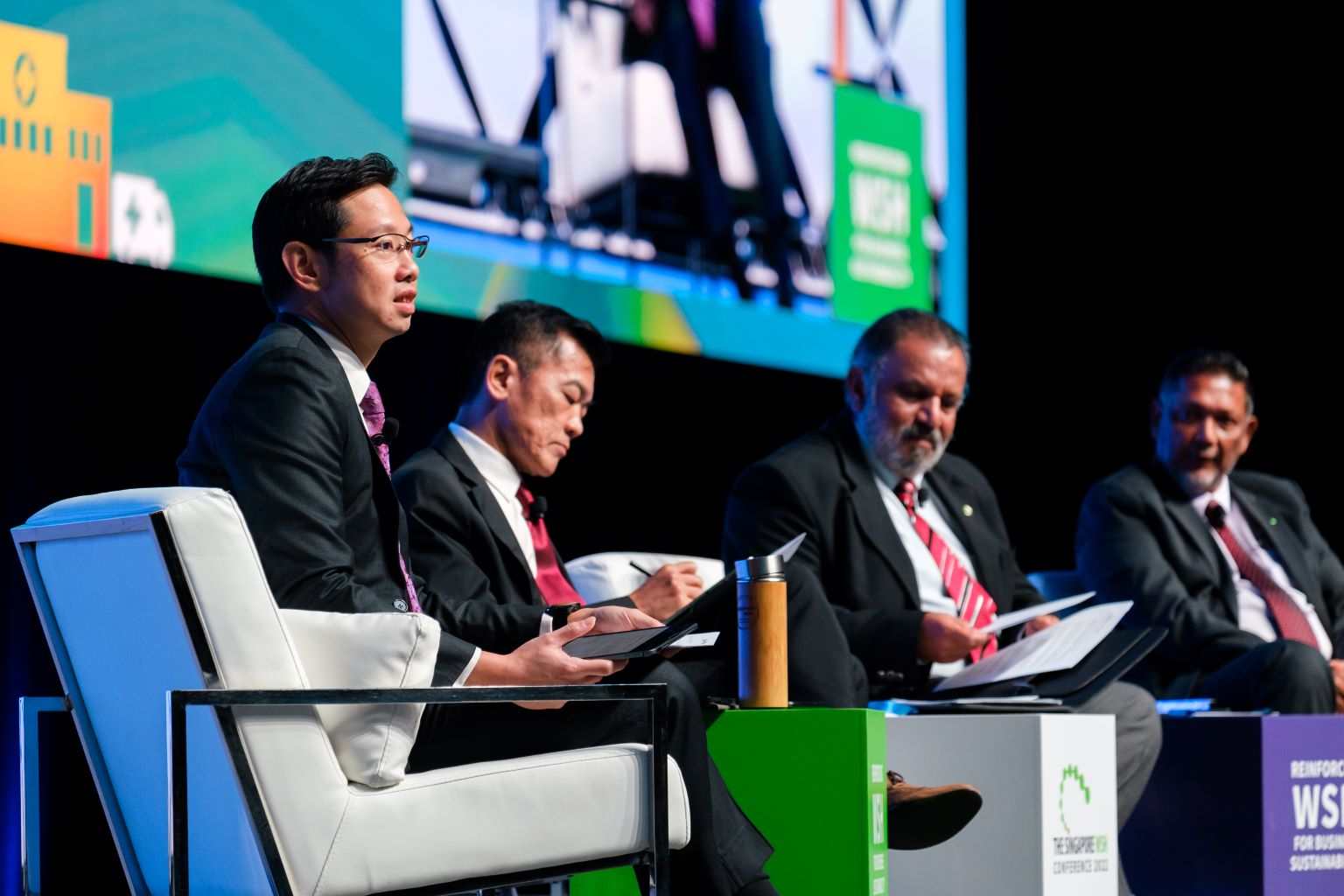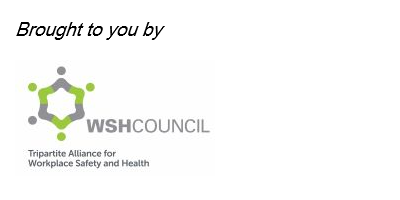BRANDED CONTENT
S’pore sets new safety record, but there is still room for progress, says WSH Council chairman
To achieve zero fatality, safety must be a key part of business culture and operations, not just a set of rules to follow

Singapore may have achieved a workplace fatality rate below one for the first time in its history, but workplace safety is still a work in progress, says the chairman of the Workplace Safety and Health Council. PHOTO: GETTY IMAGES
Charlotte Kng
Follow topic:
Behind every workplace safety and health (WSH) statistic lies a human story. These numbers are not just cold data points – they represent lives saved or lost.
In 2023, 10 more lives were kept safe in Singapore as the city-state set a new safety record in the workplace. The fatality rate fell to 0.99 per 100,000 workers for the first time since Singapore started compiling records 16 years ago.
Today, Singapore stands among the countries with the lowest workplace fatal injury rates in the world (see table below for countries with the lowest workplace fatality rates).
Even so, efforts to ensure every worker has a safe and healthy work environment continue, says Mr Abu Bakar Mohd Nor, chairman of the WSH Council in Singapore. The WSH Council, a statutory body under the Ministry of Manpower (MOM), works with industries to improve workplace safety and health.
“No matter how low the numbers get, they represent human lives,” he says in an interview.
Having spent more than three decades in the field since he joined Keppel Shipyard as an assistant safety officer in 1990 taught the 58-year-old that workplace safety is not about numbers – it is about sending everyone home alive.
No one, he stresses, should have to get injured at the workplace or, even worse, lose his or her life.
Under Mr Abu Bakar's leadership, the WSH Council has striven to make safety practices more accessible and affordable across all industries. The goal is to level the playing field for all companies, especially small businesses that are resource-constrained, through initiatives such as bite-sized guidance materials in various languages and stronger WSH support provided at small and medium-sized enterprises (SME) centres.
Recently, Singapore also more than doubled the maximum fines for workplace safety breaches to strengthen deterrence against practices that can result in serious injuries and fatalities. New rules to prevent accidents continue to be rolled out, especially for high-risk sectors such as construction, manufacturing, and transportation and storage.
Studying the best in the world
Since it was established, the WSH Council has been working closely with MOM, various industry sectors, government agencies and unions to raise WSH standards in Singapore.
In 2006, MOM formed the International Advisory Panel (IAP) for WSH, enabling the council to tap the expertise of WSH experts from countries such as Australia, Finland, Germany, Korea, the United Kingdom and the United States to identify key trends in Singapore and adopt, where relevant, the best practices around the world.
Says Mr Silas Sng, commissioner for WSH in Singapore: “To be the best, we have to learn from the best. We need to look beyond Singapore to discover new practices that can further raise our WSH standards.
“The formation of the IAP not only gives us the platform to seek advice on our WSH road maps and strategies, but also the opportunity to learn from the experience of other nations, whether it be successes or failures.”
In its early years, the council primarily focused on outreach and promoting WSH programmes. With guidance from the IAP, it has since shifted towards a more collaborative approach, engaging key stakeholders such as companies and unions in implementing best practices.
Construction firm Gammon Pte Ltd is one company that has benefited from collaborating with the council. “Working with experts under the WSH Assistance Visits programme has helped us identify potential hazards and areas for improvement. The detailed report and actionable recommendations we gained from the programme have immensely improved our safety protocols,” says Mr Muhammad Isbahi Diman, safety manager at Gammon.
Lum Chang Interior Pte Ltd, a specialist interior contracting firm, observed a notable reduction in accidents and injuries after using tools like CultureSAFE and participating in Total WSH and WSH Advocate programmes.
Mr Steve Gan, a WSH manager at Lum Chang Interior, adds that the programmes also led to a heightened awareness of safety practices among the company’s employees.
Although WSH initiatives and programmes run all year round, the council has strategically created platforms for broader conversations to take place, offering local companies and other key stakeholders valuable insights. Come September, businesses, industry experts, unions and government representatives will gather at The Singapore WSH Conference 2024 to discuss new trends and ways to further improve WSH standards.
Dr Park Doo-Yong, a member of the IAP from South Korea and former president of the Korea Occupational Safety and Health Agency, points out that the WSH Council's ability to drive substantial participation from various stakeholders has been a key factor in the successful implementation of safety protocols and collaboration within workplaces.
He says: “In this regard, Singapore's WSH Council stands out as a model that could be beneficial for other countries. WSH practices are deeply intertwined with social and cultural contexts, making it challenging to directly apply one country's policies to another. However, we can certainly draw inspiration from the successes of other nations.”

According to Ms Sarah Albon, another member of the IAP and chief executive of the Health and Safety Executive in the UK, Singapore’s agility when faced with WSH challenges is a key factor for its success in keeping fatality rates low.
Recalling a surge in workplace fatalities following the reopening of borders in 2022 after the Covid-19 pandemic, she says: “The Multi-Agency Workplace Safety and Health Taskforce was formed very swiftly to clamp down on workplace safety breaches and introduce stricter penalties for non-compliance. This demonstrated both the collaborative nature of the Singaporean system and the inherent flexibility in its approach.”
And the results were telling: From 46 workplace deaths in 2022 – which translates to 1.3 per 100,000 workers – the number fell to 36 in 2023.
To Mr Abu Bakar, the achievement was possible only with an all-hands-on-deck approach. He says: “This is the result of collective efforts from the industry associations, unions, government bodies, as well as dedication from companies and workers.”
Building a safety-conscious workforce
While the reduction in workplace fatality numbers marks significant progress, industry experts emphasise that the journey is far from over. Continuous improvement requires addressing deeply rooted misconceptions about workplace safety and health, says Mr Abu Bakar.
“Many still think that accidents are inevitable and that investing in safety measures is too costly and not worth it,” he says.
While changing such antiquated attitudes and beliefs will take time, having leaders who prioritise WSH can jump-start the process. “When top management prioritises WSH, it can permeate throughout the entire company culture more easily.”
The WSH Council has drawn up plans for collaborative networks where company leaders of different industries come together to share safety experiences, fostering a culture of safety awareness and prevention.
“We want to create opportunities for them to learn from one another how their companies have prevented accidents and benefited from strong WSH processes,” adds Mr Abu Bakar.
Besides influencing top management, the council is also looking into initiatives that can incentivise SMEs to invest in WSH. One way would be to encourage companies that are major customers of SMEs to nudge these firms to raise their WSH capabilities and standards.
By linking strong safety practices to increased business opportunities, companies will be motivated to prioritise workplace safety – ultimately making it second nature in company culture.
Says Ms Albon: “In a way, this is a greater challenge than putting in place effective systems to prevent and penalise safety offences. It is about ensuring that health and safety is seen as on a par with profitability and efficiency; that reducing injuries and near-misses, admitting and learning from mistakes becomes commonplace and part of the culture.”
About the Workplace Safety and Health Awards
The annual Workplace Safety and Health (WSH) Awards, organised by the WSH Council and supported by the Ministry of Manpower, honour companies and individuals for their exemplary WSH achievements.
This year, the awards also include the bizSAFE Awards, which recognise enterprises that have demonstrated outstanding risk management and dedication towards raising WSH standards within their business network. A total of 323 awards will be presented to 168 companies this evening at the awards ceremony.
The awards feature 10 categories: WSH Developer Awards, WSH Performance Awards, bizSAFE Partner Awards, bizSAFE Enterprise Exemplary Awards, Culture of Acceptance, Respect and Empathy (CARE) Awards, WSH Innovation Awards, WSH Tech Awards, WSH Officer Awards, WSH Awards for Supervisors and Safety and Health Award Recognition for Projects.


